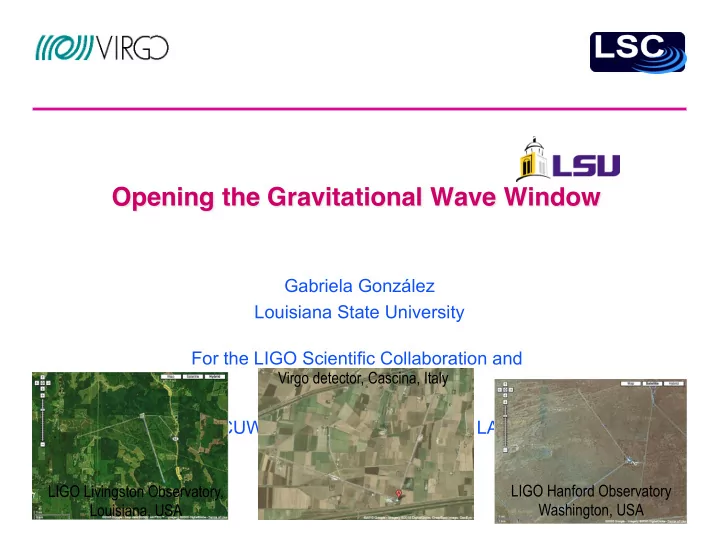

Opening the Gravitational Wave Window � Gabriela González Louisiana State University For the LIGO Scientific Collaboration and Virgo detector, Cascina, Italy the Virgo Collaboration CUWIP meeting, Baton Rouge, LA January 19, 2014 LIGO Livingston Observatory, LIGO Hanford Observatory Louisiana, USA Washington, USA LIGO-G1301143
Newtons’ gravity � “Newton’s law”: F = Gm 1 m 2 /r 2 Explains why apples fall, why the planets move around the Sun,… LIGO-G1301143
Einstein’s gravity � sciencebulletins.amnh.org And in YouTube! LIGO-G1301143
Einstein’s gravitation � When masses move, they wrinkle the space time fabric, making other masses move… Explains just as well as Newtons’ why things fall and planetary motion… Einstein’s messengers, National Science Foundation video www.einsteinsmessengers.org .. but it also predicts traveling away from moving masses! LIGO-G1301143
From stars living in galaxies … Where do gravitational waves come from? � LIGO-G1301143
From stars living in galaxies … Supernova explosions (that form a BH or a NS) Where do gravitational waves come from? � Credits: Animation: NASA/CXC/D.Berry & A.Hobart LIGO-G1301143
From stars living in galaxies … Rotating stars (pulsars) Where do gravitational waves come from? � Credit: NASA/CXC/ASU/J.Hester et al. LIGO-G1301143
From stars living in galaxies … Supernova explosions Rotating stars (pulsars) Where do gravitational waves come from? � Binary systems coalescing into a black hole Credit: John Rowe LIGO-G1301143
From stars living in galaxies … Supernova explosions Rotating stars (pulsars) Where do gravitational waves come from? � ..and from the beginning of the Universe! Binary systems coalescing into a black hole Credit: NASA/WMAP LIGO-G1301143
How to detect gravitational waves with an interferometer � Einstein’s messengers, National Science Foundation video http://www.einsteinsmessengers.org/ LIGO-G1301143
Gravitational waves: how big? � Gravitational waves are quadrupolar distortions of distances between freely falling masses. They are produced by time-varying mass quadrupoles. G µ ν = 8 π G c 4 T µ ν ( = 0 in vacuum) h = Δ L g µ ν = η µ ν + h µ ν L 11 � LIGO-G1301143
The LIGO Observatories � Hanford, WA Livingston, LA LIGO-G1301143
The GW Detector Network 2005-2010 LIGO Hanford GEO600 Virgo LIGO Livingston 13 13 � LIGO-G1301143
LIGO Scientific Collaboration www.ligo.org � • 900+ members, 86+ institutions, 17 countries https://www.zeemaps.com/map?group=245330 roster.ligo.org 14 � LIGO-G1301143
LIGO Detectors 2009-10 (S6) � 10 -19 Crab pulsar (NASA, Chandra Observatory) Hanford 4 km S6 Livingston 4 km S6 Initial LIGO Science Requirement 10 -20 Strain (1/ √ Hz) Strain (1/ Hz) 10 -21 10 -22 10 -23 NASA, WMAP 2 3 4 5 6 7 8 9 2 3 4 5 6 7 8 9 2 3 4 5 6 7 8 9 10 2 10 3 10 4 ? Frequency (Hz) Find all LSC results and publications in www.ligo.org - science tab 15 � LIGO-G1301143
Some interesting results 2005-2011 � Astrophys. J. 681 (2008) 1419 atlasofthe universe.com GRB070201 GW100916 Phys. Rev D85 (2012) 082002 16 � LIGO-G1301143
In progress: Advanced LIGO � Vacuum system – same as initial LIGO US NSF funding for Advanced LIGO: 2008-2015. 17 � LIGO-G1301143
More on Adv LIGO: LIGO magazine in www.ligo.org � 18 � LIGO-G1301143
Are we there yet? � Neutron Star Binaries: Initial LIGO: Average BNS reach ~15 Mpc → rate ~1/50yrs Advanced LIGO: ~ 200 Mpc “Realistic rate” ~ 40/year (but can be 0.4-400) Other binary systems: NS-BH: 0.004/yr → 10/yr BH-BH: 0.007/yr → 20/yr Class. Quant. Grav. 27 , 173001 (2010) 19 � LIGO-G1301143
Coming soon near you: Advanced GW Detectors running! � arXiv:1304.0670 20 � LIGO-G1301143
The GW Detector Network~2020 Advanced LIGO GEO600 Hanford Advanced Virgo KAGRA Advanced LIGO LIGO-India Livingston 21 21 � LIGO-G1301143
Multi-messenger astronomy � The astrophysical events we expect produce electromagnetic waves, gravitational waves, neutrinos … we need all eyes and ears open! 22 � LIGO-G1301143
Gravitational waves are coming! � www.ligo.org 23 � LIGO-G1301143
Recommend
More recommend